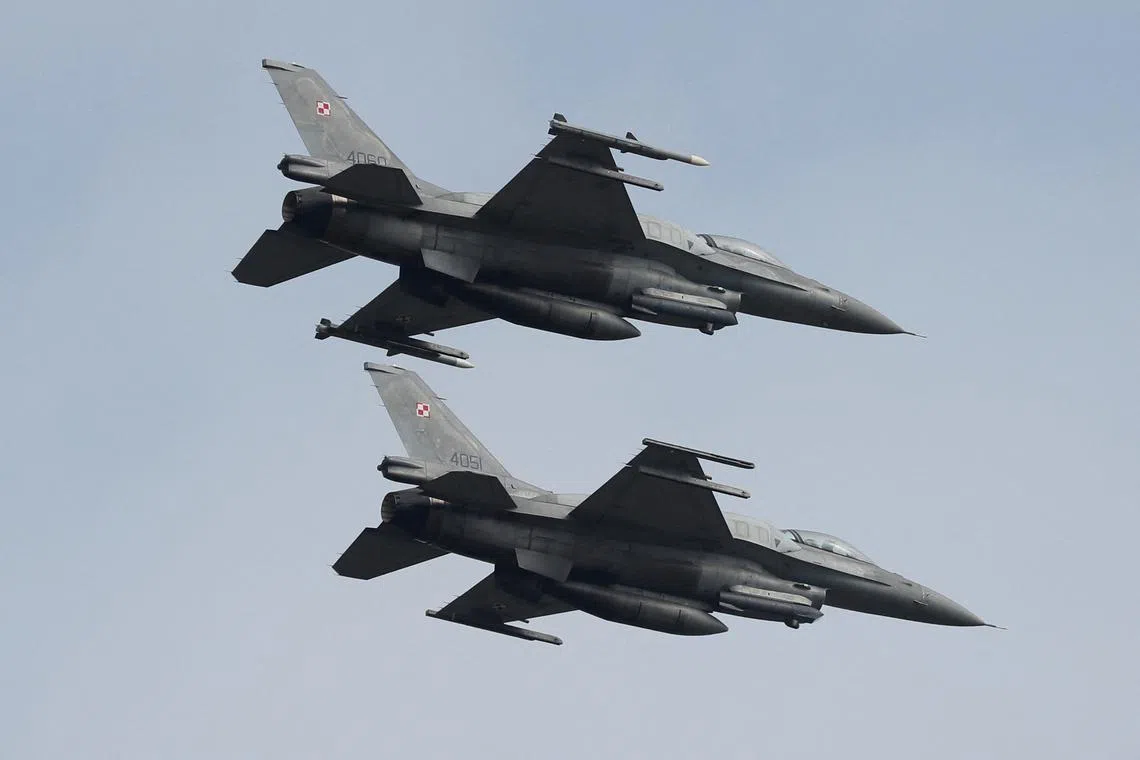Ukrainian airbase under fire as Russia aims at F-16 arrivals
Sign up now: Get ST's newsletters delivered to your inbox

The first F-16 planes are expected to arrive in July, and Ukraine hopes they will boost forces struggling to repel a Russian onslaught along the front line.
PHOTO: REUTERS
Follow topic:
STAROKOSTIANTYNIV, Ukraine - Explosions reverberated across the pre-dawn sky as Ukrainian air defences fended off a Russian attack on this small city in western Ukraine, home to an important airbase and a frequent target of Moscow’s strikes.
Hours after the hit, Starokostiantyniv’s tidy streets had returned to a semblance of normality.
But the June 27 attack was a stark reminder of the challenges Kyiv faces as it rebuilds its depleted air force and deploys the first US-designed F-16s fighter aircraft
The first planes are expected to arrive
Officials have not revealed where the F-16s will be based, but Moscow said after the June 27 strike on Starokostiantyniv that it had targeted airfields it believed would house them.
The airbase has come under frequent attack since the first days of Russia’s February 2022 invasion
Residents of the military outpost of around 30,000 people, nicknamed Starkon, in Ukraine’s Khmelnytskyi region have learnt to adjust to the constant danger.
“In short, it’s ‘fun’ to live here,” city official and local culture expert Vasyl Muliar said with a wry smile, after the recent attack.
A Ukrainian air force spokesman said the strikes presented “certain difficulties”, but would not undermine the delivery of F-16s or their use in battle.
Officials are tight-lipped about details of attacks on objects such as military bases and critical infrastructure.
Military analysts said the Russians were probably targeting airbase infrastructure such as runways and storage facilities to make getting F-16s airborne more difficult and, when they arrive, the Western jets themselves.
The Ukrainian military, which is low on air-defence ammunition, is also likely to be forced to move the prized planes around airfields, said Mr Justin Bronk of the Royal United Services Institute.
“Any ground-based air defence coverage can be saturated if the Russians care enough to fire enough missiles at one target,” he said.
Debris in cherry trees
After the June 27 attack, Governor Serhiy Tyurin said air defences had destroyed nine targets over his region.
Shortly before that, the air force had warned residents that drones were headed towards Starokostiantyniv.
Local residents, careful not to divulge what might be considered sensitive military information, described living under the threat of being struck and amid the frequent roar of Ukrainian warplanes in the skies above.
Ms Iryna Sapchuk, editor-in-chief of local newspaper Our City, said her parents’ home had been hit in a previous raid, damaging the roof and shed.
“They found debris from a missile in a cherry tree by the window,” she added.
As in many other towns and cities across Ukraine, people appeared eager to project a sense of resilience despite the danger of war and inconvenience of frequent power outages caused by Russian attacks on the energy system
Road works continued as jets streaked overhead, while families and groups of teenagers cooled off at the local beach.
When she travels around Ukraine, Ms Sapchuk said, she found it hard to cope without the noise of airplanes.
“It’s too quiet for me,” she joked, adding that the sound had become a comforting sign that Ukraine’s outnumbered pilots were putting up a fight.
Mr Muliar, the local official, pointed to the city’s history as a 16th-century bastion of defence and, hundreds of years later, a key nerve centre for independence fighters of the fledgling Ukrainian People’s Republic after World War I. “This was always a centre of resistance,” he said. REUTERS

